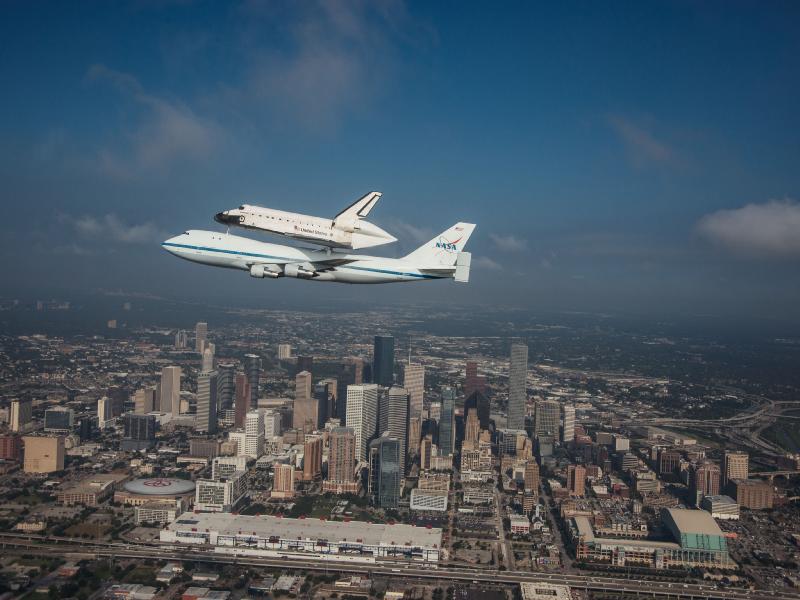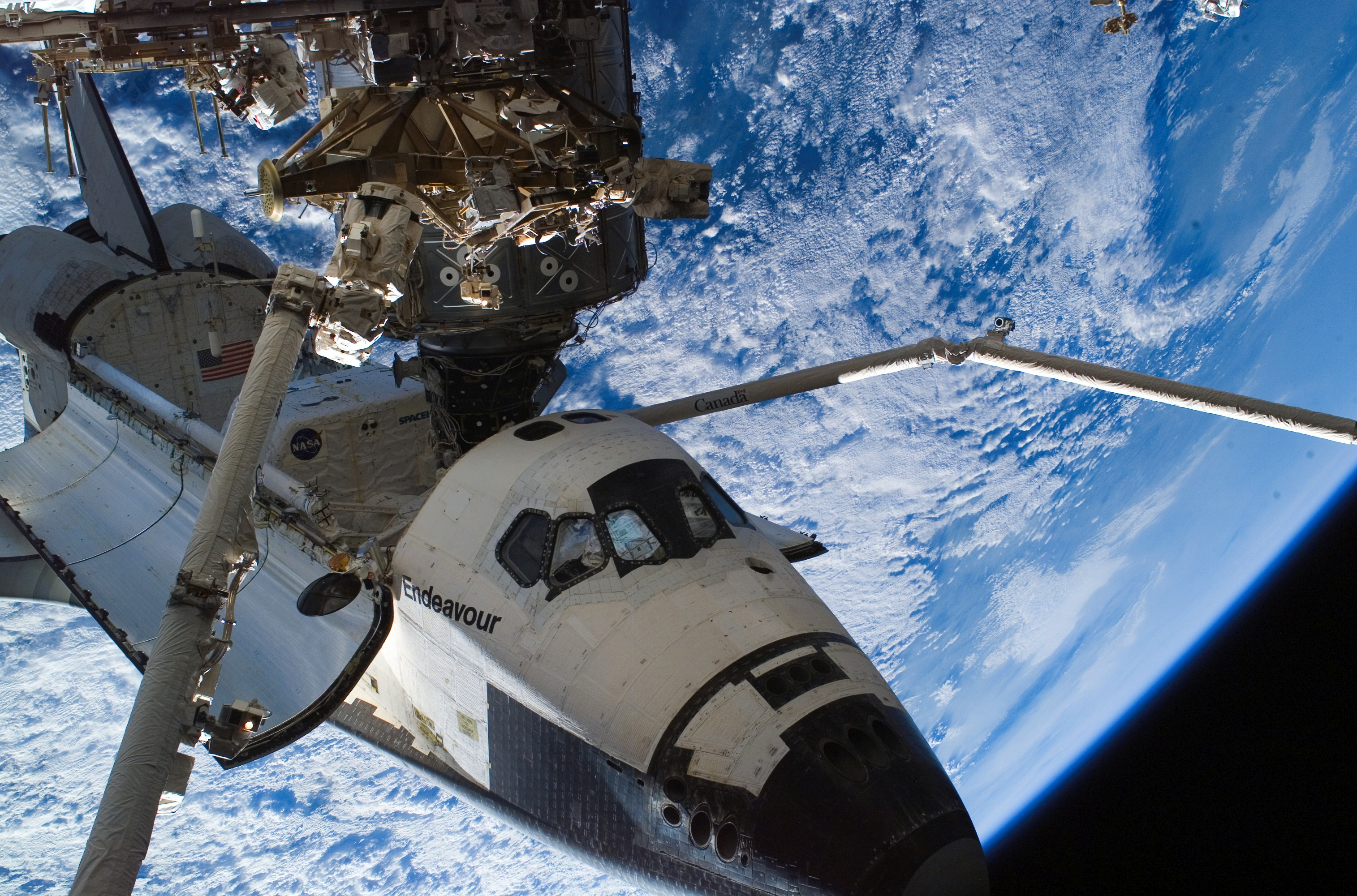
Endeavour over Houston, September 19, 2012, en route to California. CLICK FOR ZOOM (Phot0-credit: NASA)
Today, the U.S. Space Shuttle Program will take its final flight. At 8:15 am PDT this morning, Endeavour will begin a fly-over of northern California and the Los Angeles area atop the 747 Shuttle Carrier Aircraft. At about 12:45 pm PDT she will land at LAX, headed for permanent display at the California Science Center.
The Student Spaceflight Experiment Program (SSEP) began on Endeavour, in fact Endeavour’s final flight to orbit as STS-134, with liftoff from Kennedy Space Center at 8:56 am EDT, May 16, 2011. This June 2011 video of Endeavour docked at ISS is stunning, and was a poignant reminder to all the students, teachers, and communities participating in SSEP on STS-134, of what they had done – for aboard her in this video are the first SSEP experiments. That very first payload had 15 experiments selected from 447 proposals from student research teams.
We thought she’d be the last Shuttle to orbit, but in the 11th hour NASA gave the go-ahead to fly one more re-supply mission to Station, and Atlantis (STS-135) took off from Kennedy at 11:29 am EDT, July 8, 2011. We watched the last Shuttle soar from KARS Park, on the KSC grounds, with 11 SSEP experiments aboard. The SSEP communities had received 530 proposals.
And SSEP is now part of the new history being written in the post-Shuttle era, with the Mission 1 to ISS payload of experiments transported to orbit on the SpaceX Dragon in May 2012 – the first commercial vehicle to dock with the International Space Station. The Mission 1 flight opportunity saw submission of 779 proposals from 3,500 student researchers, and 12 were selected to fly.
This October 7, in just a couple of weeks, the Mission 2 to ISS payload of experiments, and the Mission 1 re-flight payload will be aboard SpaceX-1, the first operational flight of the Dragon. Mission 2 saw 1,125 proposals from 3,900 students with 11 selected to fly.
Now Mission 3 to ISS − the 5th SSEP flight opportunity in just 2 years – is now underway in 17 communities as of September 17, 2012. The Mission 3 payload may be aboard the first Orbital Sciences Cygnus vehicle, launching atop the Antares rocket from MARS – the Mid-Atlantic Regional Spaceport on the Virginia coast in Spring 2013. We are indeed part of history.
To all that want to witness the end of an era, NASA TV will cover Endeavour’s final flight live, starting at 11 am EDT (8 am PDT). You can watch at the bottom of this post, in the NASA TV widow provided.
Finally, in honor of Endeavour, and to re-affirm my sense that we are on the cusp of a rebirth of America’s human spaceflight program with commercial space playing a critical role, I thought I’d re-post a short essay I wrote at Huffington Post in February 2010, before SSEP was even a rough sketch on a napkin at a local restaurant. For me, it is remarkable to compare my concern back then about the post-Shuttle era and whether commercial space could step to the plate, to the achievements of commercial space in the intervening 2.5 years. And it is comforting to know that SSEP and all those educators that toil on its behalf in communities across America, and now Canada, for our future generation, are helping to herald in this new era. We stand on the legacy of the Shuttle program, and SSEP can honor that legacy by introducing hundreds of thousands of student explorers to the high frontier.

Endeavour in orbit on flight STS-118, August 15, 2007. For a breathtaking closeup, click on this photo. (Photo-credit NASA)
(February 7, 2010) A different kind of countdown has begun. It is now 2010. Before the next New Year’s celebration, the U.S. Space Shuttle program will be just a memory. Those that took pride in following along as this remarkable vehicle broke the surly bonds of Earth will surely feel they’ve lost a friend, and the pain of a very personal page turned forever will linger for quite some time. Those of you that follow news of the day as daily ritual, every so often hearing about a Space Shuttle blasting off or returning to Earth, will no longer experience that quick smile acknowledging pride in American leadership and technological prowess — at least not when it comes to human spaceflight. (Are there really that many areas left where America excels?)
The older generations world-wide will tell children what it was like to see a Shuttle blast off. It’s a sight that will be preserved in perpetuity on the internet, or whatever the internet will morph into. But in just 5 or 6 years we will be telling children about that time through which we lived when the Shuttle was flying — and these children will have no memory of it, for they will have been born in the post-shuttle age. Soon, the ancient history of Apollo will marry with the ancient history of the Space Shuttle for this new generation.
You and I are not alone in our living memories of Shuttle. Half the people alive today didn’t even know of a time when the Shuttle wasn’t flying, all of them born after April 1981 when John Young and Robert Crippen piloted Columbia into space as STS-1.
What’s the future for America in human spaceflight? The current long term plan for at least getting humans to low earth orbit — which is where you’ll find the International Space Station, a pretty hefty taxpayer investment — is to hand responsibility over to commercial companies with no current track record of getting even a single human there. So I’d like to put those companies on notice here. You’ve got big shoes to fill, and a spacefaring nation that is watching. You need to do us proud.
Looking back from the here and now, to just 2.5 years ago when I wrote that post, commercial space has thus far done us stunningly proud. We are in orbit with Dragon, and soon Cygnus, and crewed vehicles are next. Congratulations to all the men and women at SpaceX – all of whom were children once that dared to dream – for realizing the vision of Dragon, and we look forward with anticipation to Orbital Science’s first launch of Cygnus.
NASA TV
SSEP is undertaken by the National Center for Earth and Space Science Education (NCESSE) in partnership with NanoRacks LLC. This on-orbit research opportunity is enabled through NanoRacks LLC, which is working in partnership with NASA under a Space Act Agreement as part of the utilization of the International Space Station as a National Laboratory.
SSEP is the first pre-college STEM (Science, Technology, Engineering, and Math) education program that is both a U.S. national initiative and implemented as an on-orbit commercial space venture.




